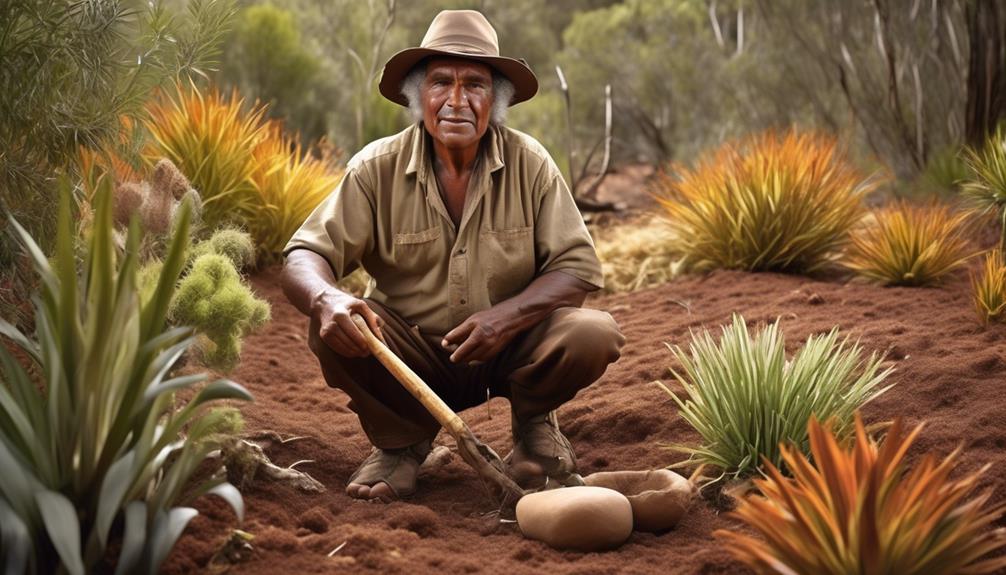Have you ever thought about what might have motivated Indigenous Australians to consider embracing agricultural practices?
The quest for understanding the potential for agricultural practices among Indigenous communities has sparked numerous discussions and inquiries.
As we explore this topic, it becomes evident that various pieces of evidence offer intriguing insights into the possibility of agricultural choices made by Aboriginal Australians.
These clues, spanning from archaeological findings to environmental indicators, contribute to a complex tapestry of the historical and cultural landscape, leaving us with compelling reasons to explore the potential for agricultural decision-making among these communities.
Key Takeaways
- Aboriginal Australians engaged in sustainable land management through controlled burning and landscape manipulation, indicating their ability to actively manage and shape their environment.
- Ancient grain-grinding tools and other archaeological evidence suggest that Aboriginal Australians cultivated and processed grains, challenging the notion that they were solely reliant on wild resources.
- Aboriginal Australians demonstrated a holistic understanding of ecosystems and employed traditional practices of seed selection, propagation, and land management to promote plant growth and cultivation.
- Environmental factors such as climate suitability, access to water sources, and soil fertility levels played a significant role in determining the feasibility and success of Aboriginal Australian agricultural practices.
Aboriginal Australian Agricultural Practices
Recent archaeological evidence suggests that Aboriginal Australians actively engaged in agricultural practices, challenging previous assumptions about their nomadic hunter-gatherer lifestyle. The traditional view depicted Aboriginal Australians as purely hunter-gatherers, but recent findings indicate a more complex relationship with the land. Through sustainable land management, they utilized controlled burning to encourage the growth of certain plant species, indicating a deliberate effort to manipulate the landscape in a way that supported their food resources. This challenges the notion that they were solely reliant on wild resources and highlights their deep understanding of the environment.
The discovery of ancient grain-grinding tools further supports the argument for Aboriginal Australians practicing agriculture. These tools, dating back thousands of years, provide tangible evidence of their cultivation and processing of grains. This revelation reshapes our understanding of their lifestyle, indicating a sophisticated approach to food production and resource management. It suggests that they actively selected and cultivated plant species, challenging the previously held belief that their food sources were solely obtained through hunting and gathering.
These insights into sustainable land management and early agricultural practices among Aboriginal Australians present a compelling narrative of their resourcefulness and environmental stewardship. The shift in perspective from a purely hunter-gatherer lifestyle to one that incorporates intentional land management and plant cultivation opens up new avenues for understanding the complex relationship between Aboriginal Australians and their environment.
Archaeological Evidence of Early Farming

While exploring ancient archaeological sites, we've uncovered compelling evidence of early farming practices among Aboriginal Australians. The archaeological evidence supports the existence of early settlements and the domestication of plants, indicating a shift towards agricultural lifestyles. Our findings suggest that Aboriginal Australians actively engaged in plant domestication, challenging previous assumptions about their nomadic hunter-gatherer lifestyle. The evidence points towards intentional cultivation and management of plant resources, indicating a sophisticated understanding of agricultural practices.
- Discovery of grinding stones and seed grinding tools at ancient sites
- Identification of charred plant remains indicating deliberate use of fire for land clearance
- Unearthing of agricultural plots and irrigation systems
- Examination of ancient plant DNA revealing signs of domestication
- Analysis of soil composition and pollen samples indicating deliberate cultivation and land management
These discoveries not only shed light on the agricultural capabilities of early Aboriginal Australians but also challenge existing narratives about the development of agriculture. The evidence suggests a complex and intentional engagement with plant cultivation, indicating a deliberate choice towards early farming practices.
Environmental Factors and Agricultural Potential
Our examination of the archaeological evidence of early farming practices among Aboriginal Australians has led us to investigate the significant role of environmental factors in shaping the agricultural potential of the region. When considering the possibility of Aboriginal Australians choosing agriculture, it is crucial to evaluate the environmental context, including climate suitability, land management, soil fertility, and water availability. These factors play a pivotal role in determining the feasibility and success of agricultural practices.
| Environmental Factors | Agricultural Potential |
|---|---|
| Climate Suitability | Varied climates across Australia influenced the types of crops that could be cultivated and the timing of planting and harvesting. |
| Land Management | Indigenous land management practices, such as controlled burning, influenced the diversity and productivity of plant species. |
| Soil Fertility | Understanding soil types and their fertility levels is essential for determining suitable agricultural practices. Aboriginal Australians had deep knowledge of local soils and their potential for cultivation. |
| Water Availability | Access to water sources and the ability to manage water for irrigation significantly impacted the agricultural potential of different regions. |
Indigenous Knowledge of Plant Cultivation

Analyzing the indigenous knowledge of plant cultivation among Aboriginal Australians reveals a complex and sophisticated understanding of local flora and their cultivation techniques. Traditional techniques employed by Aboriginal Australians for sustainable farming exhibit a deep connection to the land and a profound respect for nature. This knowledge has been passed down through generations, preserving valuable insights into cultivating indigenous plants for food security.
Intergenerational Knowledge Transfer: The transmission of plant cultivation methods across generations reflects the cultural significance and practical efficacy of indigenous techniques.
Holistic Understanding of Ecosystems: Aboriginal approaches to plant cultivation demonstrate a holistic understanding of ecosystems, promoting biodiversity and soil health.
Adaptive Farming Practices: Indigenous farming practices showcase adaptability to diverse environmental conditions, emphasizing resilience and sustainability.
Ethical Considerations: Aboriginal plant cultivation methods prioritize ethical considerations, aligning with environmentally conscious and sustainable approaches.
Community-Centric Systems: Plant cultivation techniques are deeply intertwined with community livelihoods, fostering social cohesion and shared responsibility for food production.
The incorporation of indigenous knowledge into contemporary agricultural practices can enrich global sustainability efforts by promoting ecological balance and enhancing food security for communities worldwide.
Potential for Agricultural Decision-Making

Drawing from the insights into Aboriginal Australians' sophisticated understanding of plant cultivation, we now turn our attention to the potential for agricultural decision-making within indigenous communities.
Land management played a crucial role in the agricultural practices of Aboriginal Australians. The careful selection of suitable areas for cultivation, along with the use of controlled burning to clear land, demonstrates a deliberate and informed approach to land use. This suggests a level of agricultural decision-making that's often underappreciated in historical narratives.
Furthermore, the concept of food security was inherently tied to Aboriginal Australians' agricultural practices. The intentional cultivation of certain plant species, such as yams and grains, indicates a strategic effort to ensure a stable and sustainable food supply. This reflects a deep understanding of the relationship between land use and food production, highlighting the sophistication of agricultural decision-making within indigenous communities.
Frequently Asked Questions
How Did the Introduction of Agriculture Impact the Social Structure and Cultural Practices of Aboriginal Australian Communities?
The introduction of agriculture significantly impacted the social structure and cultural practices of Aboriginal Australian communities.
Social impact was evident in the shift from nomadic to settled lifestyles, leading to the development of more complex social hierarchies.
Cultural adaptation was seen in the cultivation of new crops and the emergence of specialized roles within the community.
These changes influenced traditions, rituals, and kinship systems, demonstrating a profound transformation in Aboriginal Australian societies.
What Role Did Climate and Environmental Changes Play in the Development of Agricultural Practices Among Aboriginal Australians?
Climate influence and environmental adaptation are crucial factors in the development of agricultural practices among Aboriginal Australians. The changing climate and environmental conditions necessitated innovative responses for sustenance.
We can observe how these factors would have influenced the decisions made by Aboriginal communities regarding agricultural practices. Understanding the impact of these elements provides insight into the resilience and adaptive capabilities of these communities in the face of environmental challenges.
Are There Any Oral Traditions or Stories Passed Down Through Generations That Provide Insight Into the Decision-Making Process Behind Adopting Agricultural Practices?
Oral traditions and generational stories provide valuable insights into the decision-making process behind adopting agricultural practices. These narratives shed light on the cultural impact of such decisions and the evolution of social structures.
Understanding the motivations and thought processes through these stories enriches our understanding of how agricultural practices were integrated into Aboriginal Australian societies. This evidence-based approach allows us to appreciate the complexities of their historical choices and the factors that influenced them.
What Methods Did Aboriginal Australians Use to Manage and Cultivate Crops in Different Regions and Environments?
We observe that Aboriginal Australians employed diverse crop management techniques, adapting to varying environments. They skillfully employed firestick farming, creating favorable conditions for plant growth and managing vegetation.
Additionally, they implemented sophisticated aquaculture systems, manipulating water resources to cultivate crops. Such adept environmental adaptation and resource management suggest a rich agricultural knowledge base.
This evidence underscores their capacity for agricultural development, offering insights into their decision-making processes.
How Did the Introduction of Agriculture Impact the Biodiversity and Ecosystem of the Australian Landscape?
The introduction of agriculture significantly impacted the biodiversity of the Australian landscape. As ecosystems adapted to human intervention, biodiversity flourished in cultivated areas while native vegetation dwindled.
The shift towards agriculture altered the balance of native species, resulting in both positive and negative effects on the ecosystem.
This impact highlights the complex relationship between human activity and the environment, emphasizing the need for sustainable practices to maintain biodiversity.
Conclusion
In conclusion,
while some may argue that there's limited evidence of early agriculture among Aboriginal Australians,
the archaeological findings,
environmental factors,
and indigenous knowledge
all point to the potential for intentional cultivation practices.
By considering these factors,
we can gain a deeper understanding of the complex decision-making processes
that could have led to the development of agriculture in ancient Australia.
Mary is a passionate writer who brings creativity and a fresh perspective to our team. Her words have the power to captivate and inspire, making her an essential contributor to our content. Mary’s commitment to storytelling and dedication to promoting Indigenous culture ensures that her work touches the hearts of our readers. We’re fortunate to have her as part of our team.










